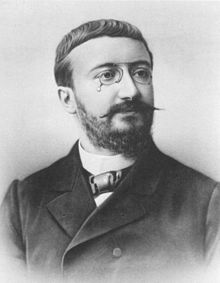Binet-Simon test
The Binet-Simon test is the first good intelligence test to be used in psychology . With him the psychometry was founded. The Binet-Simon test was developed in 1905 by Alfred Binet and Théodore Simon ; Revisions appeared in 1908 and 1911. Lewis Madison Terman developed it into the Stanford-Binet test .
As director of the psychophysiological institute of the Sorbonne , he and Victor Henri (1872–1940) began to develop tests for mental performance . The procedures developed so far, u. a. by James McKeen Cattell , Hugo Münsterberg and Hermann Ebbinghaus , produced completely different results. Binet criticized them for being too specific; he sought to measure a more general capacity, which he defined as "the way of coping with a current situation ... judging well, understanding well and thinking well".
After the introduction of compulsory schooling in France in 1882, children who were overwhelmed by normal school lessons were referred to special schools by subjective teacher judgment. In 1904, the French Ministry of Education commissioned a working committee to develop an objective test to identify the children in need. Binet and the doctor Théodore Simon (1873–1961) were also appointed to this commission, and they were able to use the first version of their test a year later.
The test
First, Binet was looking for test items that could only be mastered as clearly as possible from a certain age, so that the average age of the population is identical to the age of intelligence.
Task examples:
- can differentiate right and left (from 6 years)
- can count backwards from 20 to 0 (from 8 years)
- can bring randomly arranged words into a meaningful sentence (ages 11 and up).
Intelligence age
A person's intelligence age was calculated as follows: First, the so-called basic age was determined, namely the age whose tasks were all solved. Additionally solved tasks from older age groups were added as monthly shares.
Example 1: (There are 6 tasks to be solved for each age group, so that each correct answer adds 2 months to the intelligence age): A six-year-old child solves all tasks in age groups 1–5, three in group 6 and 1 each in groups 7 and 8. Add (3 + 1 + 1) * 2 = 10 months to the base age 5 and you get an intelligence age of 5; 10 years.
Example 2: A six-year-old child solves all tasks in age groups 1–7 and 1 each in groups 8 and 9. To the basic age of 7, add (1 + 1) * 2 = 4 months and get an intelligence age of 7.4 years.
criticism
A difference (lead or lag) between life and intelligence age is much more dramatic at a young age than at an older age. A five-year-old child with intelligence age 4 has a much worse prognosis than a ten-year-old child with intelligence age 9 ("The scissors are falling apart.")
This problem prompted William Stern to relate age and intelligence age and thus invent the " intelligence quotient " (IQ):
Similarly, there is a formula for the intelligence age:
For example, if a 10-year-old child has an IQ of 120, he is assigned an intelligence age of 12 years.
Original essays
- Alfred Binet, Victor Henri: La psychology individual. In: L'Année Psychologique. Vol. 2, 1895, ISSN 0003-5033 , pp. 411-463, doi : 10.3406 / psy.1895.1541 .
- Alfred Binet, Théodore Simon: Methodes nouvelles pour le diagnostiqc du niveau intellectuel des anormaux. In: L'Année Psychologique. Vol. 11, 1904, pp. 191-244, doi : 10.3406 / psy.1904.3675 .
literature
- Manfred Amelang et al .: Differential Psychology and Personality Research. 6th, completely revised edition. Kohlhammer, Stuttgart 2006, ISBN 3-17-018640-X .
- Joachim Funke : Alfred Binet (1857 to 1911) and the world's first intelligence test. In: Georg Lamberti (ed.): Intelligence on the test stand. 100 years of psychometrics. Vandenhoeck & Ruprecht, Göttingen 2006, ISBN 3-525-46241-7 , pp. 23-40.
- Literature on the Binet-Simon test in the SWB library catalog


